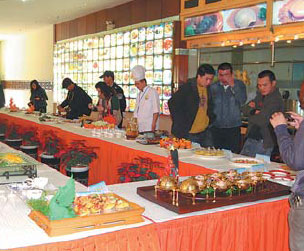Seafood trade, skills have rich history
Zhanjiang was one of China's earliest hubs for the ancient maritime Silk Road, according to historical documents that indicated trade with Southeast Asia and Indian Ocean-rim countries took place more than 2,000 years ago.
But archaeological findings show that production and trade in seafood began much earlier. Even today, the coastal city is remembered for its variety and high quality of seafood.
In 1982, Neolithic ruins were discovered in Zhanjiang's Suixi county. At the site, archaeologists found fossil remains of fish and shellfish species, both cooked and uncooked, as well as fishing tools, indicating seafood production there has a history of more than 7,000 years.
Production and trade developed further during the Qin (221-207 BC) and Han (202 BC-AD 220) dynasties, with the use of boats and a range of fishing tools. Oysters were among the most popular catches of that period.
In the Song Dynasty (AD 960-1279), large quantities of yellow croaker were exported to foreign countries.
During the Ming (1368-1644) and Qing (1644-1911) dynasties, high-quality abalones from the region were transported to Beijing as tributes to the emperors.
Whale fishing, a highly skilled and technical trade, flourished during the period. Whale fat, which was used by nobles as lamp fuel, became another renowned local tribute to the royal family. The number of whaling ships surpassed 100 at the trade's peak between the late Ming and early Qing dynasties.
Fishing on the sea is still popular among local fishermen, though aquaculture has become increasingly important in seafood production.
People from Zhanjiang love the sea, seafood and fishing and their seafaring tradition has grown into an important part of the local culture that is reflected in the folk songs and poems popular among locals.
The popular folk songs are closely related to the local seafood production and the songs are embedded in everyday life. Important rituals like weddings are usually accompanied by songs about fishing.
Famous Song Dynasty poet Su Dongpo, who visited the region during his trip to Hainan, described the local life in one of his poems:
"Seafood trading is usually made by females/Wherever they gather, there is a temporary fair/There will be three to four such fairs a day as they move/And the majority of the goods are commonly seen fish and shrimps."
Zhanjiang has been the cradle of China's top seafood chefs in history. Today, thousands of chefs from the city have been working throughout China and the world, promoting their local cuisine, brands and a seafood-related culture.
Local statistics show that more than 1,000 Zhanjiang chefs are working overseas, including more than 300 in Japan.
The local catering industry has played an important role in cultivating top seafood chefs.
Zhanjiang Jinhai Hotel, for instance, has a bonus system based on customer satisfaction, encouraging them to improve skills to meet the diversified demands of clients, said Lin Jianzhong, general manager of the hotel.
Based on the city's rich and unique seafood resources, Lin said the local culinary industry has long featured a highly natural way of cooking but now has more sophisticated cooking styles.
zhaoshijun@chinadaily.com.cn
|
Thousands of chefs from Zhanjiang currently work in China and abroad, according to the city government. |
|
Zhanjiang will organize a seafood procurement fair to market its unique seafood cuisine. Photos Provided To China Daily |
(China Daily 05/30/2016 page8)










